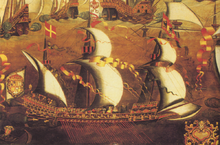Galeas (military ship type)


The galeasse (also Galjäß ; name derived from the Italian Galea grossa ) was a military combination of sailing ship and rowing ship and was developed in the early 16th century as a further development from the late medieval galley .
Galleries were typically around 50 meters long and had between 800 and 1200 men on board. The sails consisted of three or four masts, each with a latin sail . Draft, length and weight were significantly higher than in the more agile galleys. So the galleys could also carry significantly more armament than galleys. Galleries were built higher than galleys and were therefore difficult to board. While all the guns were concentrated at the bow of the galleys of this era , the armament of the galeas was distributed over the entire ship, on the oar deck or on a deck above the oarsmen . Galeaces could fire to port and starboard , while the galleys of that time could only fire in the direction of travel. So it was calculated that the fighting strength of a galeas corresponded to the fighting strength of five galleys.
Henry VIII had more than a dozen galleries built in the 1530s and 1540s. In 1549, the oars were removed from many galeasses and they were classified as pure sailing ships, in the 1550s the remaining galeasses were converted into galleons .
In the Mediterranean, with its lower waves and weaker winds, galeasses were used longer, especially by the Republic of Venice and the Ottoman Empire . A large use of the ship type took place in the naval battle of Lepanto in 1571. There six Venetian galeas made a significant contribution to the victory of the Holy League .
In the naval battle of Gravelines in 1588, in which the Spanish Armada fought against the English fleet, galeas with 18 cannons and 26 light guns were used on the Spanish side. Despite the subsequent retreat and the victory of the English, they were able to defend themselves particularly strongly against the constant winds to the coast and in the Atlantic, in contrast to the Spanish galleys, which had their strengths primarily in boarding combat.
However, since galeasses were clearly inferior to sailing ships like the galleons on the high seas, this type of ship disappeared quickly from the world's oceans after the 16th century.